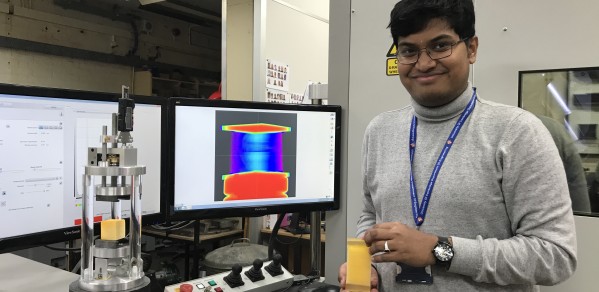
Angkur joins the Department as the inaugural Ashby Research Fellow following his doctoral research on developing a design protocol for the failure of three-dimensional architected materials.
Problems never come with a subject tag and hence research should be collaborative. I want to collaborate with a biologist, a neurologist or may be a philosopher apart from engineers and mathematicians.
Angkur Shaikeea
Angkur has worked extensively on X-ray CT for material characterisation and developed in-situ experimental protocols in mechanics. He has previously worked on experimental fluid mechanics using micro-PIV and light sheet imaging for characterising the behaviour of nanocolloidal sessile droplets. He is interviewed below:
When did it become clear to you that you wanted to pursue a career in research?
It grew slowly in me. Initially it started with the curiosity to understand how machines work and then with hands-on engineering research became a more personal goal and career objective.
How is the Ashby Fellowship different from other research fellowships e.g. Junior Research Fellowships?
Ashby Fellowship is primarily linked to the Department of Engineering. It provides a strong platform to collaborate with current researchers in the Department as well as develop external collaborations. There is a mentor for suggestions on funding opportunities and career guidance. The recipient can take up supervisions and laboratory demonstrations to boost their teaching skills. The experience of Cambridge is incomplete without access to one of the colleges, and this fellowship is rightfully associated with Pembroke College making the three years stay a very holistic experience.
What will be your research under this fellowship?
I will be exploring the potentials of using X-ray tomography as a quantitative technique for experiments in mechanics like obtaining three-dimensional strain maps, imperfection characterisation in architected solids for measuring distribution of voids and cracks. The idea is to transfer traditional experiments to lab-based X-ray CT and extract tomographic information, both qualitative and quantitative data.
How did you get interested in the field of X-ray CT?
It was during my PhD that I was introduced to the X-ray CT facilities in rigor. There were many challenging problems like performing triaxial experiments and detecting failure in an embedded crack which motivated me to dwell more into the method. I have spent hundreds of scan hours and even more in analysis of raw data.
What are the potential applications?
There are two sides to my research- a vast industrial application where parts need to be monitored during their lifetime for safe and efficient operation, and there is this research aspect to characterise the mechanical behaviour in a wide range of materials from batteries to soft solids.
What motivates your work more — the experiments or the applications?
They are intertwined. The moment you develop a new experimental method the most reasonable question is – application. I love to build products as much as I love to solve problems so experiments naturally follow with the hunt for applications and sometimes the need/application motivates the experiments.
What are your long-term plans for research, will you continue with XCT?
There are several uncovered territories with XCT, and I am sure there will be more challenging problems to follow. My imagination is XCT will become a tabletop device very soon and I would rather become a user than doing research on it. I can see myself doing a lot of curiosity driven projects or building experimental tools. One of the areas is 3D microfluidic devices- a completely untouched territory or using quantum algorithms for image analysis in large datasets. I have very naively worked on cancer research, using MRI scans for tumour distinction and would like to spend more time on this. Problems never come with a subject tag and hence research should be collaborative. I want to collaborate with a biologist, a neurologist or may be a philosopher apart from engineers and mathematicians.
How has working in this field affected your career decisions?
I am getting more drawn towards academia.
Apart from research, what do you like to do?
I enjoy teaching. I do quite a few supervisions in the engineering subjects. Busking music/playing tabla, poetry, photography, and cricket helps me keep a balance between research and life.
Philanthropic support of the Department of Engineering:
The Ashby Postdoctoral Fellowship in Mechanics and Materials Fellowship has recently been established in honour of the pioneering research by Professor M F Ashby CBE, FRS, FREng. The Fellowship is for 3 years.
The Ashby Postdoctoral Fellow is given the opportunity to pursue independent research in the general area of mechanics and materials, as well as to contribute to ongoing research in the Mechanics and/or Materials Groups. Research activities in mechanics and materials are broadly interpreted.
The fellowship has been established with generous donations from Professor Ashby, David and Susan Hibbitt, and from friends, colleagues and past students of Professor Ashby.
Postgraduate support and early career fellowships help the Department attract and retain the best young academics, and give recipients the opportunity to jumpstart their academic careers through access to exceptional mentorship, research and teaching opportunities.
To discuss philanthropic support of the Department of Engineering, please contact Ann Cernek (Associate Director – Engineering) at ann.cernek@admin.cam.ac.uk.

